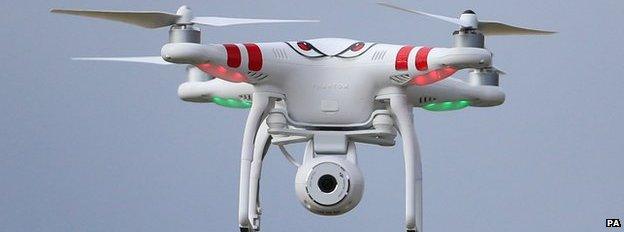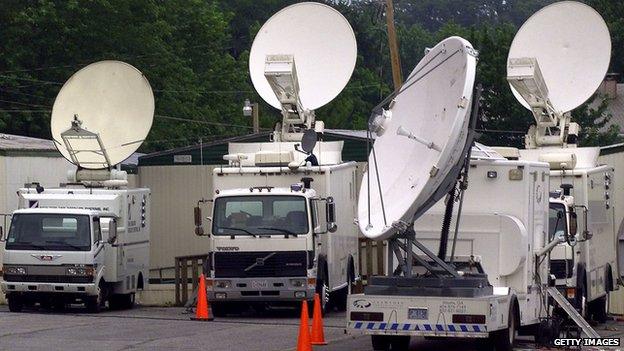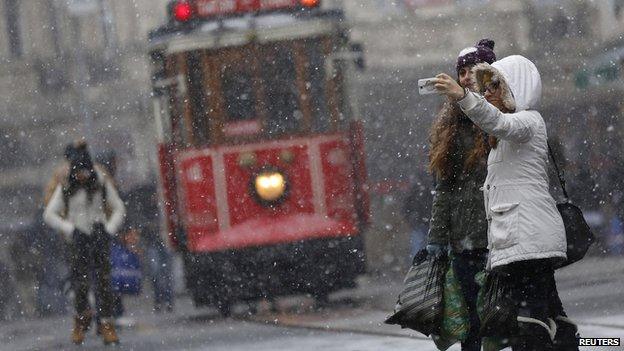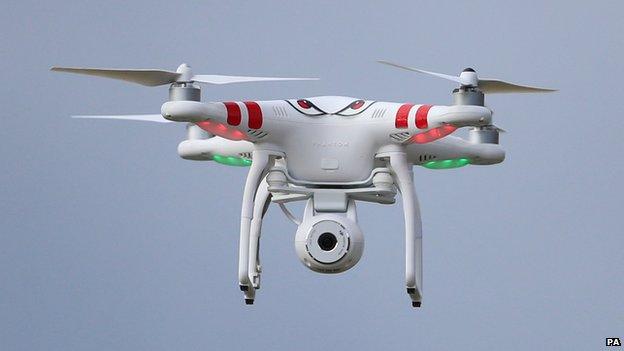Future of News: Seven insane ways tech will change news
- Published

The BBC, like many media organisations, is having a major head-scratching session about the whole future of news.
As part of this exercise, I've been asked to write about the way technology could change the news business over the next decade.
When I sat down to think about this, I realised that while there were bits of gadgetry that are changing the way we gather and distribute news, the primary challenge comes from new platforms and software.
And what is particularly scary for wizened veterans of the news business like me is the sudden appearance of the likes of Buzzfeed and Vice News, organisations which seem able to lure audiences into consuming serious news with gimmicks such as listicles and clickbait headlines.
Ah well, if you can't beat them...
1. Oh my, we've all gone mobile
.jpg)
With breathtaking speed, the internet has gone mobile, with more than half of the UK population now in possession of a hugely powerful computer in the form of a smartphone.
News organisations still struggling to get to grips with the idea of "internet first" must quickly adapt to "mobile first" - that is where their audiences are going to be.
If you haven't got a mobile app that's as good as, if not better than, any of your existing platforms, you will soon be toast. And as mobile networks improve, text will not be enough - users will expect engaging video content too.
2. I am a camera

The spread of the smartphone means just about everyone inside and outside your news organisation now has a camera and can be a news gatherer. All kinds of wearable cameras are also coming on to the market, though one, Google Glass, has already disappeared.
What this means is that just about any news event is likely to be recorded by someone, so apps that make it easy for anyone to get their footage to a news organisation are going to become more important. And the task for those who must sift through it all will get ever more arduous.
3. Live from the sky

Going live from around the world has been a vital but expensive priority for television news organisations for many years, with satellite costs still very high.
As mobile and broadband networks get faster and cheaper, it's becoming much easier. And now we are entering the age of the drone, you can soon expect to see live aerial pictures beamed down to a reporter or producer's smartphone and then out to the world.
4. Snapchat me your Reddit over WhatsApp

The social media landscape is getting more fragmented - Facebook still has a huge audience, but millions of young people are now using other ways to communicate.
That means news organisations have to dip their toes into all sorts of unfamiliar pools in the attempt to reach this audience. Tweeting is no longer enough, you have to have a presence on everything from WhatsApp to Reddit.
Some may work - Instagram and Vine are proving useful ways of getting short news clips to millions of people. Others will prove a dead end - I can't quite see how Snapchat is anything other than a place for private conversations. But experimentation is vital for journalists trying to stay in touch.
5. The kids are alright

Teenagers are now finding their news in less traditional ways
Which brings us to the depressing fact that 16-24 year olds have better things to do than read newspapers or watch the TV news.
But hold on a minute - ask a British teenager for their views on events in Ferguson, Missouri, or the latest news about Ebola and you may find they're better informed than their parents.
On everything from Tumblr to various games forums, they're sharing links to news stories and discussing issues that matter to them. Journalists just have to find ways of being part of that conversation.
6. Money for something

There is no money in news - that has been the frightening truth that has crept up on news organisations as the internet has laid bare their threadbare economics.
No longer can property and job adverts keep regional newspapers afloat, television channels are asking difficult questions about the cost of their news operations, and on the internet readers and viewers expect to get expect everything for free.
Hold on a minute - some people are making money from news, and lots of it. Two terrible terms - "branded content" and "native advertising" - are behind the healthy finances of expanding media businesses like Buzzfeed.
What they mean, according to the doomsayers, is an increasingly hazy line between journalism and advertising. But optimists say that has always been the case and there is nothing wrong with advertisers wanting to be associated with popular journalism.
7. Content still counts

Here's the good news for those who fear a future of endless live, Snapchatty, linkbaity celebrity nonsense, all sponsored by Evil Megacorp PLC.
There is growing evidence of an appetite for in-depth news. The blog platform Medium found that its most successful articles were around 1,600 words long and took seven minutes to read. Vice News has had nearly four million views on YouTube for a series of reports from Ukraine, all of them a good deal longer than a standard TV news package.
And while technology is making it easier and cheaper for anyone to spread their news to the world, both editors and audiences still value specialist knowledge and skills. And no, everything doesn't have to be in the form of a list.
